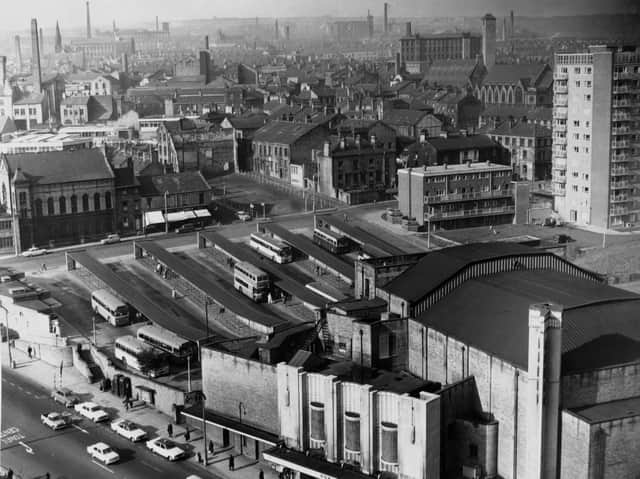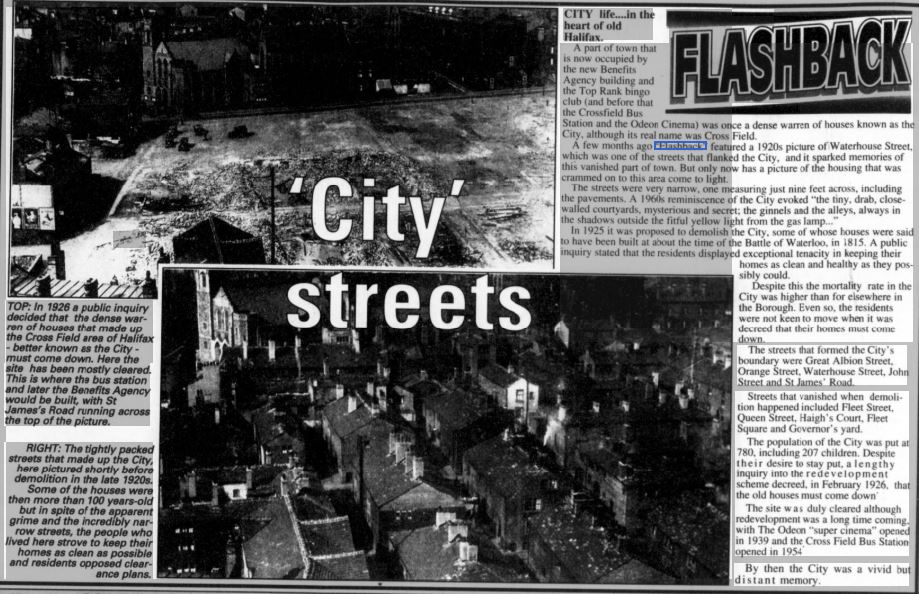

The City was generally regarded as the small square highlighted in the map above and was a tight network of squalid, terraced housing for the lower class workers, usually working in the mills and factories around the bottom of Pellon Lane and at the Dean Clough mills. But this page also looks at the wider area of similar housing at 'Stannary' and shows the living standards which, along with many other areas at the time, deemed 'unfit for use' in the government report mainly due to size, sanitary and living conditions.

The main road on the right of the photo is Pellon Lane (bottom of picture travels up towards town). A large area was demolished to make way for the Odeon and what became the bus station but was still a car park in the above photo

Pellon Lane runs from left to right (towards town) in the top half of the picture.

top - North Bridge, centre - Corporation Street(left to right)
 |
 |
Looking up Pellon Lane with the Grand Junction Hotel on the left and Ebenezer Primitive Methodist Church on the right
 |
 |
 |
 |

This bottom half of this photo captures nearly all of 'The City' area.
St.James's Road

 |
 |







See Alhambra - OddFellows Hall




First buses moved into and through Cross Field bus station in the mid-fifties, more than a decade and a half after the opening of the Odeon on the 'City' site



The 4 pictures above show a clear time lapse of the 'Before and After' demolition views of the St. James's Road area.

Looking in the opposite direction



St James's Church, pictured behind the shop in the photo above, was at one time, the third oldest church in Halifax, after the Parish church and the Holy Trinity. For many years, the first two churches could cope with the religious needs of the town, but when the Rev Titus Knight became the vicar of Halifax he set about the task of providing for the growing population of the town and decided the town needed five churches.
Plans for the erection of St. James's were not completed until Archdeacon Musgrave became vicar of Halifax. It was opened for public worship on Jan 2nd 1832. It's architecture is decidedly original, although it should be pointed out that the first plan that the architect submitted was for a building of singular beauty. Funds were lacking, however, and the ecclesiastical authorities had to dcall for less pretentious plans.





St. James's Road with North Parade on the right

 |
 |
Stannary

 |
 |

Stannary Inn pub at the bottom of Green Lane (now Richmond Road- where the police station is)


Stannary Lane looking down towards Dean Clough (drawing by John.L.Berbiers)

Stannary House
Great Albion Street

 |
 |




Richmond Street left and Stannary St right





Stannary Inn on the junction of 2 Green Lane and Stannary Lane. There was also a brewery here in cyyages known as Seedlings Mount. Opened in 1859 and closed in 1967 as part of the Burdock Way construction.


Steve Gee
Darley Street

Steve Gee


South Darley Street

South Darley Street and Smiths Arms

The City residents

Green Hill Terrace in the Green Lane area between Stannary and Pellon Lane.


Green Hill Tavern was at 100 Pellon Lane. It opened in 1877 and closed in 1967.

The pub on the right is also Green Hill Tavern with 'The Weston' pub central.
 Weston Hotel or Western Hotel as it was known. Abel Street / 2 Lansdowne Place, Pellon Lane. |
 |

The empty building in the foreground is the former Commercial Road shop of the Halifax Industrial Society




J.Rhodes (pawnbrokers) on St.James's Road at the junction with Fleet Street (where the benefits office now stands).

Fleet Square off Fleet Street



A.Farrar upholsterers at 28 St.James's Road

on the left was the fish and chip shop run by M.Dolphin

Barbers shop, coal merchants Harries and Co, L.Arnott's ladies' and gents' tailors, I.Pollard's fish, fruit and poultry shop and a butchers offering 'choice horse flesh'.




Cock O' The North brewery
Please add your own picture and articles for everyone to enjoy by either
Email:- info@halifaxpeople.com
or
Fill out the form at the bottom of each page
Have A Great Story About This Topic?
Do you have a great story about this? Share it!
If you have enjoyed your visit to this website, please spread the word by clicking the 'like' and 'share' buttons below. Thank you




